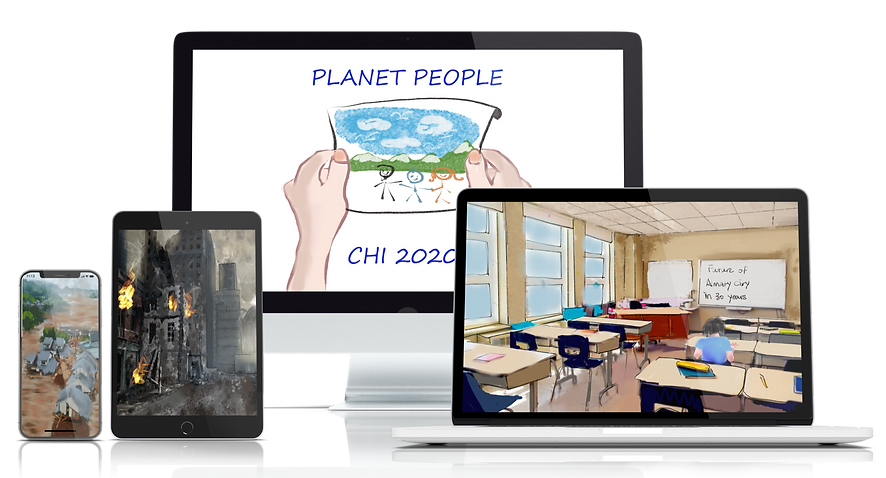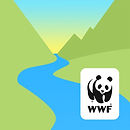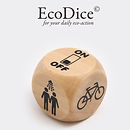Planet People

Overview
A video game development project for CHI 2020 Student Game Design Competition.
This project was developed as a part of the 2020 CHI Game Design Competition. For this, my team and I created a 2 minutes game trailer, a 2 minutes gameplay demo and a research paper. We were given two prompts out of which we choose the prompt "to expand the boundaries of the gameplay and explore the role of gamification in a non-game setting such as medical, education, sustainability, etc."
We then choose 'Environment' as the main topic of our game and carried out user research to narrow down the scope.
View full research paper HERE.
Role & Responsibilities:
UX Researcher
UX Designer
Gameplay Developer
Tools:
Unity Engine
Adobe Procreate Photoshop
After Effect Premiere Pro
Duration:
2 months
2019
Team:
Team of 5 HCI Grad Students
PROBLEM
“How to raise people's awareness of climate change and motivate people to take action protecting our Earth using gamification?”
Overall Process
We followed a comprehensive research and design path in order to tackle the prompt and come up with the most effective solution.


Research
A lot of people believe climate change needs urgent action, but there is still a vast majority of people that believe it is not a major issue as they don't feels its effects.
User Research
Earth’s climate is now changing faster than at any point in the history of modern civilization, primarily as a result of human activities. Global climate change has already resulted in a wide range of impacts across every region of the world and many sectors of the economy that are expected to grow in the coming decades. [1]
We conducted several user interviews with students and working-adults to get a better idea of people's awareness levels and feelings towards climate change. The results were quite surprising as, even highly educated students and adults think that the condition is not as bad as they cannot see its effects in their lives.
"I would not play a game because it is educational, rather I would play an entertaining game, and if it has some moral, it would effect me more."

Tabassum Nisha
Graduate Student

"I don't think climate change effects my life in away way as of now. Though I believe it may in the future. But right now I have other things to be worried about."
Fahad Iqbal
Engineer
"I believe we have to take steps now in order to preserve what we have left. If we wait even a little more, it will become irreversible."
Ruchita Lodha
Graduate Student

Competitive Analysis
We began with studying the existed game or gamification related to sustainability.
Ant Forest
Ant Forest is a mobile app by AliPay. Users are encouraged to record their low-carbon footprint through daily actions like taking public transport or paying utility bills online. For each action, they receive ‘green energy’ points and when they accumulate a certain number of points, an actual tree is planted. Users can view images of their trees in real-time via satellite. [2]
JouleBug is a mobile app that gives users an easy way to make their everyday habits more sustainable, at home, work, and play. They can discover how they and their friends can use resources, without using them up. It is free and easy to play. It can be played individually as well instead of competing with others.
This Augmented Reality game is WWF’s concerted effort to educate about how human development can either be harmful or sustainable. Through helpful little floating tips, users can learn more about the journey of water, how it impacts the area through which it flows, the people it affects and how building dams can cause damage to delicate ecological systems.
Eco-Dice offers another fun way to turn positive intentions into action. Players simply toss a die using their touch screen and, once it settles, the facing side gives you a green task to do for that day. The options include separating trash, bringing your own grocery shopping bag, sharing your shower, turning off an appliance on standby, or riding your bike to work. [3]




Literature Review
As the aim for our project is to raise peoples awareness and motivate them to take action against climate change, we carried out literature review based on motivation, habits and environment. Points that stood out:
-
Emotion attachment is vital for effecting someones behavior. Some of the emotions that make people click include: guilt, moral, achievement and pain.
-
Strengthening peoples environmental self-identity is an effective way to promote pro-environmental actions. Peer pressure and media pressure often plays a big role in this.
After the review, we could tell that the most important thing to bring about a change in people's actions is by connecting them emotionally to something. When people are emotionally attached towards something, they are more likely to action towards it.
There are several ways to get people emotionally charged up, but one of the most effective ways, which works for our project, is when a story touches their heart and makes them emotionally, viscerally and visually charged up.

Brainstorming
Over several meetings, the team sat together and brainstormed different ideas to decide the direction we want to go.
Affinity Wall
After conducting the interviews and literature review, we created na affinity wall to analyze all our findings.
-
People prefer emotional games over educational games. They are likely to change their behavior because their emotion was triggered due to the story.
-
People care about climate change but feel like they don't have the power to make a difference. They believe the small things only make a trivial change.
-
A lot of people do try to work towards the betterment of the environment, where as some people do not care at all.
-
People have tried to change their behavior when intrinsically pushed to do so.
-
People who have experienced effects of climate change, are more likely to change their lifestyle.
-
People are more likely to take action if they have visually seen effects of something, like a natural disaster.

Ideation
After thoroughly analyzing the findings of the user research and literature review, we decided to go with a story based game. We aimed at coming up with a touching storyline that would trigger a player’s emotions by immersing them in a narrative experience and witnessing the change of environment throughout a complete timeline.
During our research, we came across a New York Times article [4] about Tuyuksu glacier in Almaty, Kazakhstan. Inspired by the article, we created a story about the main character, 'Lia', who travels back to time to discover reasons behind the suffering of the people of Almaty city.

Team meeting
In the NYT article, scientists working at the Tuyuksu Glacier, have projected that in the years 2025 and 2050, the cities near the Tuyuksu glacier will face big challenges. In 2025, due to the glacial retreat, there will be a sudden high jump in the amount of of the melting water, which will lead to flooding in the highly populated areas. In contrast to 2025, the year 2050 will see draught instead of flooding. Most of the cities close to the glacier that depend on it for water supply, will encounter water shortage.
Based on these two predictions and the projected years, we generated other points in the timeline.


Game Development
We decided to use cutscene animation to present the background story as well as the interaction between characters and mini-games in between for players to interact with.
Asset & Gameplay Development
As I was responsible for developing the game, I decided to go with a 'Low-Poly' art style due to time restriction. I developed the assets and mini-games using Unity Engine.
Trailer
We made a trailer as per CHI 2020 requirements. We took inspiration from various video game trailers and combined cutscenes and gameplay to come up with a short descriptive trailer for our game.
Reflection
As a video game enthusiast, designing experiences involving games is always a wonderful journey. For me, designing a game is not just something technical but rather curating an experience that stays with the players.
For this competition, I carried out user interviews, along with my team to gather more information about what users need and what would help in achieving our goal most.
Through this project, I learnt that even though people are aware of Environmental issues, but they do not understand the urgency we are facing. This is mainly because as of now, they are not directly effected by climate change.
Also, I really enjoyed working with my team on this project. Everyone on the team was eager to learn new things and here were times when I was able to extend a helping hand and teach them something that I am well versed in, like animation.
If given more time, I would like to fully develop this game and carry out further user research to see if it actually is able to accomplish the goal of making people aware of the environmental crisis we are facing.